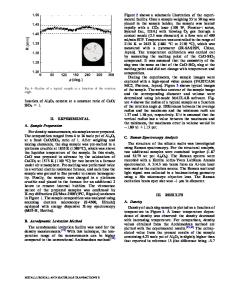Effect of Heat Treatment on the Microstructure and Microhardness of Nanostructural Al 2 O 3 Coatings
- PDF / 1,798,791 Bytes
- 11 Pages / 593.972 x 792 pts Page_size
- 67 Downloads / 326 Views
M. Kovaleva, Yu. Tyurin, N. Vasilik, O. Kolisnichenko, M. Prozorova, M. Arseenko, V. Sirota, and I. Pavlenko (Submitted February 17, 2014; in revised form June 9, 2014) Nanostructural Al2O3 coatings were formed on a steel substrate surface using a multichamber detonation sprayer. The Al2O3 coatings were characterized by a dense microstructure with porosity below 1% and hardness of 1300 ± 25 HV0.3. The transition layer between the coating and substrate was up to 15 lm thick, containing Fe-Al-type intermetallic compounds (FeAl3, Fe2Al5). Postdeposition heat treatment of the samples at 850 °C for 3 h was carried out in air and argon environments. The effect of heat treatment on the microstructure and microhardness of the Al2O3 coatings was investigated by optical microscopy, scanning and transmission electron microscopy, scanning probe microscopy, x-ray phase analysis, and Vickers hardness testing. A positive impact of postcoating heat treatment on the coating microstructure and microhardness was observed. Heat treatment resulted in an increase in the coating hardness from 1300, to 1350 ± 25 HV0.3 and 1600 ± 25 HV0.3 after annealing in air and argon, respectively. Heat treatment in argon led to a more significant increase in the a-Al2O3 phase from 47 to 81%.
Keywords
Al2O3 coating, heat treatment, microstructure, microhardness, multichamber detonation sprayer, porosity
1. Introduction Coatings made of Al2O3 powder are widely used to protect surfaces exposed to aggressive working environments at high temperatures. The widespread use of alumina coatings may be due to their attractive service properties and low cost (Ref 1-3). Thermally sprayed alumina coatings are characterized by lamellar structure (Ref 4). The porosity values of such coatings can be adjusted from several percent up to 20% by insufficient filling and incomplete wetting with liquid melt of a previously formed rough coating surface (Ref 5). Pores consist of large voids with size from several micrometers up to over 10 lm, and small, two-dimensional voids including nonbonded interfaces between
M. Kovaleva, M. Prozorova, and M. Arseenko, Joint Research Center, Belgorod State National Research University, Pobeda 85, Belgorod 308015, Russia; Yu. Tyurin and O. Kolisnichenko, E.O. Paton Electric Welding Institute, NASU, Bozhenko 11, Kiev 03650, Ukraine; N. Vasilik, N.N. Semenov Institute of Chemical Physics, RAS, Kosygina 4, Moscow 117977, Russia; and V. Sirota and I. Pavlenko, Center for Constructional Ceramics and the Engineering Prototyping, Belgorod State National Research University, Pobeda 85, Belgorod 308015, Russia. Contact e-mails: [email protected] and [email protected].
Journal of Thermal Spray Technology
lamellae and vertical cracks in individual ceramic lamellae (Ref 6, 7). Heat treatment processing is usually applied during postspraying treatment of thermally sprayed coatings. Postspraying treatment has been widely recognized in the last decade as being key to coating quality (Ref 8). In many applications, heat treatment is required to re
Data Loading...










